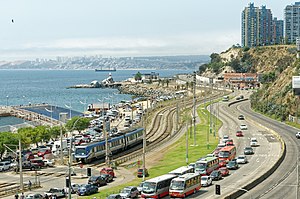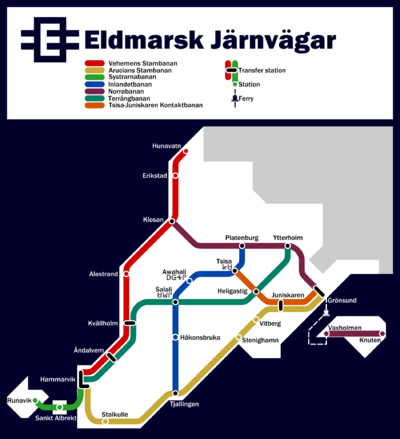Eldmark Railways
| Eldmark Railways | |||
|---|---|---|---|
 An EJ train in Hammarvik | |||
| Overview | |||
| Native name | Eldmarsk Järnväger | ||
| Status | Operational | ||
| Locale | Eldmark | ||
| Termini | Hammarvik, Grönsund, Tsisa, Klosan, Tjallingen Hunavatn, Runavik, Knuten, Platenburg, Juniskaren | ||
| Stations | 25 | ||
| Website | ej.el | ||
| Operation | |||
| Owner | The Government of Eldmark | ||
| Number of tracks | Double track | ||
| |||
Eldmark Railways (Blostlandic: Eldmarsk Järnväger) is the state-owned railways of Eldmark.
Early history
Before the invention of railroads, travel between areas of Eldmark were either performed by ship travel along the coasts, or overland on roads and trails, leading to slow transport between cities and ports. However with the construction of two "mine-to-market" freight lines in Kvallholm and Hakonsbruka in 1857, silver and gold mining grew to rely on the service for quick transport from the mountainous interior to the smelters in the urban coast. Soon passenger lines would begin to connect the coastal cities. In 1868, three passenger lines combined to form the Grand Asterian Railway Company, and lobbied the Riksdag to approve of several grants for passenger rail expansion, especially to connect the southern and eastern ends of the country, of which was predominantly underdeveloped and infrastructurally devoid of quick routes to the west. Seeing it as a necessity for national security, the Riksdag approved of the grants in return for final say on routing. Companies in the east, including the Juniskaren-Ytterholm Rail Service, of which at that time connected more than just those cities, also received a similar deal. Rail construction and travel exploded as the interior was connected to the industrial coast, and cities like Platenburg grew exponentially as rail made what was formerly inhospitable mining camps into important transport hubs.
Nationalisation
In 1927, following the creation of the Entente and with the looming of the Great War ever apparent, the Riksdag passed a series of emergency acts with the intention of ramping production and distribution of war materials such as weapons, vehicles, raw materials, and explosives, as well as ensuring compliance to the government and crown. The Grand Asterian Railway, at this point a virtual monopoly over rail transit in the nation, was discovered to have functionalists on the central board, including Hiram Lindt, Stefan Milhaus, and Frederick Bohn, the former being the chief operating officer. These three were notably against the emergency acts, and attempted to lobby the Riksdag against it. These three were removed from their roles in the company pending investigations of treason, of which the outbreak of war halted. After the outbreak of the war, executive action by Prime Minister Adolphus Dahl effectively nationalized all freight and passenger rail in the country under the title of Eldmark Rail Service.
After the war, plans to reprivatize the industry was met with stiff opposition from the AFP and even members of the National Party. Rebranded to Eldmark Railways after the war, the service reopened to general peacetime use.
Costs
Commuter services are priced based on a rate tied to distance traveled.
